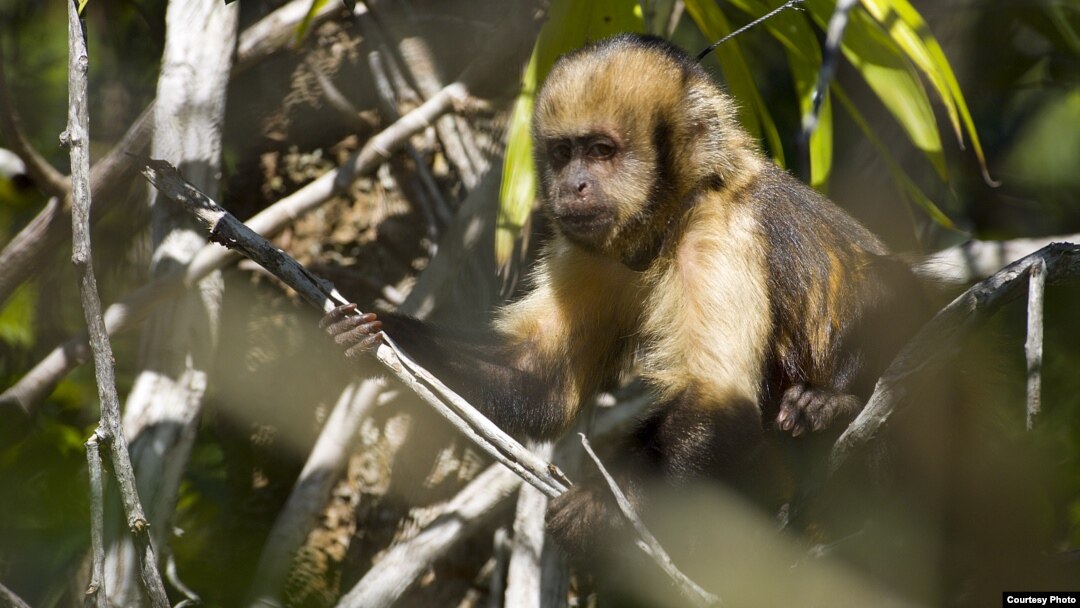The Atlantic forest in Brazil, once a part of the great Amazon basin on the South American continent, is suffering from widespread species loss according to a new study.
Ecologist Carlos Peres with England’s University of East Anglia and then University of Cambridge graduate student Gustavo Canale traveled through the region between 2003 and 2005. They documented 200 of the largest and least disturbed old-growth forest fragments in the vast region of the Atlantic forest.
On average, they found only four of the 18 mammal species they were looking for. Canale, now working in Brazil at the State University of Mato Grosso, says he and Peres drew largely on information from wildlife surveys, camera traps, and interviews with local people.
The scientists were surprised that even in what looked like healthy forest cover, the larger mammals were absent.
“The situation was worse than we thought,” Canale said.
“All the charismatic species,” said Peres, “the large primates, the large ungulates, brocket deer, tapirs, giant anteaters, jaguars, the large cats, all of those things are pretty much gone from even fragments that look on the surface of it, okay, in terms of forest cover.”
Hunting is the main driver of species loss on lands fragmented by deforestation. Peres says Brazilian law protects forest cover, but not wildlife in the remnant forest patches. Unless that law is changed, he says, the losses will continue.
“Essentially what we are calling for is a wholesale revision of the Brazilian legislative code that protects wildlife within these remnant forest patches," he said. "Because these remnant forest patches are essentially going out of business, if you like, in terms of the wildlife.”
In contrast, Peres says, in the five areas that did have laws to protect wildlife and where the laws were strictly enforced, the mammals did much better.
“In those five sites we find the highest degree of retention of those wildlife communities," he said. "So the protected areas are actually working in this region, the problem is that there are very few of them.”
The researchers want to see more such areas established, as well as the creation of wildlife corridors that would link isolated forest patches and keep animals away from hunters and other hazards. But Peres also offers a cautionary message. He says the fragmented tropical forest isn’t just a problem in the Atlantic forest of eastern Brazil.
“But I would argue that this is also happening throughout most of the world’s heavily fragmented biodiversity forest hotspots, where overhunting is also widespread,” he said.
"Holding on to the last remaining large tracts of primary forests will be a crucial part of the conservation mission of this century," Peres said.
His and Gustavo Canale’s study on Brazil’s Atlantic forest is published in this week’s edition of the journal PloS ONE.
Ecologist Carlos Peres with England’s University of East Anglia and then University of Cambridge graduate student Gustavo Canale traveled through the region between 2003 and 2005. They documented 200 of the largest and least disturbed old-growth forest fragments in the vast region of the Atlantic forest.
On average, they found only four of the 18 mammal species they were looking for. Canale, now working in Brazil at the State University of Mato Grosso, says he and Peres drew largely on information from wildlife surveys, camera traps, and interviews with local people.
The scientists were surprised that even in what looked like healthy forest cover, the larger mammals were absent.
“The situation was worse than we thought,” Canale said.
“All the charismatic species,” said Peres, “the large primates, the large ungulates, brocket deer, tapirs, giant anteaters, jaguars, the large cats, all of those things are pretty much gone from even fragments that look on the surface of it, okay, in terms of forest cover.”
Brazil’s Coastal Rainforest Suffers Species Extinction
Hunting is the main driver of species loss on lands fragmented by deforestation. Peres says Brazilian law protects forest cover, but not wildlife in the remnant forest patches. Unless that law is changed, he says, the losses will continue.
“Essentially what we are calling for is a wholesale revision of the Brazilian legislative code that protects wildlife within these remnant forest patches," he said. "Because these remnant forest patches are essentially going out of business, if you like, in terms of the wildlife.”
In contrast, Peres says, in the five areas that did have laws to protect wildlife and where the laws were strictly enforced, the mammals did much better.
“In those five sites we find the highest degree of retention of those wildlife communities," he said. "So the protected areas are actually working in this region, the problem is that there are very few of them.”
The researchers want to see more such areas established, as well as the creation of wildlife corridors that would link isolated forest patches and keep animals away from hunters and other hazards. But Peres also offers a cautionary message. He says the fragmented tropical forest isn’t just a problem in the Atlantic forest of eastern Brazil.
“But I would argue that this is also happening throughout most of the world’s heavily fragmented biodiversity forest hotspots, where overhunting is also widespread,” he said.
"Holding on to the last remaining large tracts of primary forests will be a crucial part of the conservation mission of this century," Peres said.
His and Gustavo Canale’s study on Brazil’s Atlantic forest is published in this week’s edition of the journal PloS ONE.



